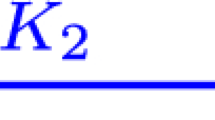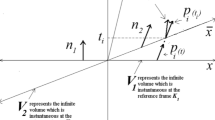Summary
Solutions are obtained for the Poincaré compensating energy-stress tensor for the classical point electron. The tensor, denoted byC ν μ, may be chosen to cancel not only the divergent self-stress integral but the divergent Coulomb self-energy as well. The mass of the compensated electron may be provided for by superimposing the energy-stress tensor of a point mass (obtained recently as a source for the Schwarzschild field). The primary role played by general relativity in solving this problem is to provide a fundamental assumption as to the structure ofC ν μ, in particular, for the static, spherically symmetric system of the point charge, we assume energy density equals radial stress. This condition leads to an absence of gravitational self-energy and self-stress and an isomorphism between general relativity and special relativity for the tensors and equations needed to solve the Coulomb self-stress and self-energy problems. The condition also leads to a linearity of Einstein’s field equations for the problem, which greatly simplifies the analysis. The compensated model of the electron would support an inertial origin of charge rather than an electromagnetic origin of mass.
Riassunto
Si dà una classe di soluzioni per il tensore dell’energia-tensione di compensazione di Poincaré per l’elettrone classico puntiforme. È possibile scegliere questo tensore,CJ*, in modo da cancellare non solo l’autotensione integrale divergente ma anche l’autoenergia. di Coulomb divergente. Si può dotare d’inerzia l’elettrone sovrapponendo il tensore energia-tensione di una massa puntiforme (la sorgente del campo di Schwarzschild). Il ruolo principale svolto dalla relatività generale nella soluzione di questo problema, sta nel dare una ipotesi fondamentale per la struttura del Cν μ; in particolare, per il sistema. statico, a simmetria sferica, della carica puntiforme, supponiamo che la densità d’energia eguagli la tensione radiale. Questa condizione porta all’assenza di autoenergia gravitazionale e di autotensione, e ad un isomorfismo fra la relatività generale e quella speciale per i tensori e le equazioni necessarie per risolvere i problemi dell’autotensione e dell’autoenergia di Coulomb. Questa condizione porta in questo problema anche ad una linearità delle equazioni di campo di Einstein, il che ne sempliflea molto lo studio. Il modello dell’elettrone compensato avvalora un’origine inerziale della carica, piuttosto che un’origine elettromagnetica della massa.
Similar content being viewed by others
References
F. R. Tangherlini:Phys. Rev. Lett.,6, 147 (1961), hereafter referred to as (I). Some of the results of (I) will be repeated here for convenience. The notation will be same as (I) except that we shall use γ instead ofG as the Newtonian gravitational constant. We have found it convenient to use unrationalized electromagnetic units (with c=l). A brief account of the present paper was given at the 1962 New York meeting of the A.P.S. SeeBull. Am. Phys. Soc.,7, 31 (1962). See also our previous paper,Nuovo Cimento,25, 1081 (1962).
A. Lees:Phil. Mag.,28, 385 (1939).
A. Pais:Developments in the Theory of the Electron (Princeton, 1948).
H. Poincaré:Rend. Ciro. Mat., Palermo,21, 124 (1906).
W. Pauli:Theory of Relativity (New York: 1958), p. 186.
H. A. Lorentz:Collected Papers, Vol.5 (The Hague, 1937), p. 314.
E. C. G. Stückelberg:Helv. Phys. Acta,14, 51 (1941). Our approach is more analogous to that ofF. Bopp:Ann. d. Phys.,38, 345 (1940).
Compare the discussion inA. S. Eddington:The Mathematical Theory of Relativity, 2nd ed. (Cambridge, 1924), p. 183. In the above argument we have put aside, for simplicity, questions of gravitational energy; these will be taken up in Section 3.
A. Einstein:Sitzber. preuss. Akad. Wiss. Phys.-Math. Kl.,20, 349 (1919).
C. W. Misner andJ. A. Wheeler:Ann. Phys.,2, 525 (1957).
P. G. Bergmann:Phys. Rev.,124, 274 (1961). Although it might appear that any kind of isomorphism between general relativity and special relativity is out of the question,ab initio, because for the one case the space-time manifold is not flat and in the other case it is, it should be noted that when special relativistic theories are written in generally covariant form, the group of transformations admitted by both theories are the same: The group of all continuous co-ordinate transformations. The transforming quantities of the two theories are in general different (e.g. gμν. However, it can happen that under suitable conditions of symmetry (or degeneracy) a subset of the transforming quantities are the same,i.e., there is a one-one form-preserving correspondance,e.g. the mixed energy-stress tensor under the conditions stated above.
H. Hönl andA. Papapetrou:Zeits. f. Phys.,112, 65 (1939); alsoR. Arnowitt, S. Deser andC. W. Misner:Phys. Rev.,120, 313, 321 (1960). Briefly, the cut-off arises because at the origin of the co-ordinate systems adopted by these authors, the « point » electron has finite area, as discussed by Hönl and Papapetrou.
G. Wentzel:Zeits. f. Phys.,86, 429 (1933). See also,P. A. M. Dirac:Proc. Roy. Soc. A.,167, 148 (1938). For an interesting historical account, seeM. Jammer:Concepts of Mass (Cambridge, Mass., 1961).
H. Bauer:Zeits. J. Phys.,29, 954 (1928), in a comprchensive review of solutions to the field equation for static systems with spherical symmetry. The relation g00g11 = constant plays a central role in the review ofF. Kottler:Ann. d. Phys.,56, 401 (1918). Our own independent approach stemmed in part from an attempt to clarify the relationship of goog11 = constant to the principle of equivalence, as suggested byH. Bondi andS. Kilmister:Am,. Journ. Phys.,28, 508 (1960).
H. Reissner:Ann. Phys.,50, 106 (1916), who solves the problem in proper radial co-ordinates. See also the remark inJ. L. Synge:Relativity, The General Theory (Amsterdam, 1960), p. 268. It should be noted that we do not destroy the isomorphism by working in these other co-ordinate systems. If we write the special relativistic stress-equilibrium equation in generally covariant form, and make the above co-ordinate transformation r = ϱ exp [μ(ϱ)/2], the stress-equilibrium equation in special relativity of course has precisely the same form as above
For a criticism of this kind of approach seeV. Fock:The Theory of Space Time and Gravitation (London, 1959), p. 208.
G. Nordström:Proc. Amst. Acad. of Sciences,20, 1230 (1918), in this paper, he also explicitly calculates t0 0. For the case of the Schwarzschild field, the result was independently arrived at by E. Schrödinger:Phys. Zeit.,19, 4 (1918). However, the more general expression (3.4) does not appear to have been given.
H. L. Zatzkis:Phys. Rev.,81, 1023 (1951).
G. Nordström:Proc. Amst. Acad. of Sciences,20, 1080 (1918).R. C. Tolman:Phys. Rev.,35, 875 (1930). Compare alsoE. T. Whittaker:Proc. Roy. Soc., A149, 384 (1935);C. Møller:Ann. of Phys.,12, 118 (1961);4, 347 (1958).
K. M. Case andS. G. Gasiorowicz:Phys. Rev.,125, 1055 (1961).
Author information
Authors and Affiliations
Rights and permissions
About this article
Cite this article
Tangherlini, P.R. General relativistic approach to the poincaré compensating stresses for the classical point electron. Nuovo Cim 26, 497–524 (1962). https://doi.org/10.1007/BF02771821
Received:
Published:
Issue Date:
DOI: https://doi.org/10.1007/BF02771821




